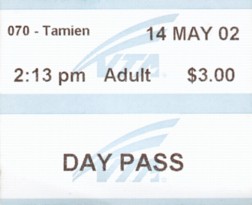

Today, I was on two quests. I wanted to ride the entire route of the historic trolley line in San Francisco, and I wanted to try to buy the two relatively new TV Guide editions available in certain parts of the Bay Area. The reason for both of these quests: I'm a big geek.
I took BART to Powell Street just like yesterday, but this time took the Powell and Mason cable car to where it lets off, near Fisherman's Wharf and near one end of the trolley route. The last time I was in San Francisco, 15 years ago, the transit authority's fleet of historic trolleys was running along Market Street as part of a summer-only "Trolley Festival," but since then, it's been made a full-time route, it was extended along the Embarcadero to Fisherman's Wharf, and there are more historic trolleys in the fleet than there used to be.

| One of the trolleys that were originally in service in Milan, Italy (being followed by a sightseeing bus disguised as a cable car). My father and I rode one of these in 1987, and Cat and I rode one Monday evening, so I was hoping to ride on something different. |

| As it turned out, the first car at the layover loop was this PCC car, originally from Philadelphia, but now painted to honor Louisville, Kentucky. I climbed aboard and did, indeed, ride all the way to the end of the line near Market and Castro Streets. (This may be hard to believe for those of you reading this who were Northwestern freshmen after I was, but there were 'L' cars of a similar design that would occasionally show up on the Evanston line up until the summer of 1993. They looked like this. I know they don't look that similar on the outside, but trust me, on the inside, they were almost identical.) |
And an example of the value of having a 3-day unlimited pass: near the end of the trolley line along Market Street, I alertly spotted a Safeway and realized they would most likely have TV Guides for sale. To get back there, I went down to the subway and took the next light rail train one stop back the way I had come, went upstairs, crossed the street, and ended up with a copy of the San Francisco County edition of TV Guide.
I then headed for where I could find the other of the two editions: San Jose. I started by taking the light rail to the Caltrain commuter train terminal, which involved changing trains; during that portion of the adventure, a team of fare inspectors showed up and made the same train change I did at the next station down the line, so I had to show my pass twice. (Actually, I'd had to show my pass three times, because although San Francisco recently switched to a "proof of payment" system on the light rail lines, at the subway stations, there are still turnstiles for paying cash fares and an agent in a booth to unlock the turnstile if you have a pass or a bus transfer.)


Even though I think I'm only going to make a simple round trip, I buy a "day pass" just in case, for the low, low price of $3.00. It turns out that the mall really is right next to one of the stops (well, across a street and a parking lot, but that's about as close to "right next to" as one can hope for when referring to the relationship between a mall and a transit line in California). I have a late lunch, find a San Jose transit map at the mall's information desk, and then find the Santa Clara County edition of TV Guide at a Walgreen's that's across the parking lot from the mall, in the other direction from the light rail stop.
Mission accomplished, but I end up taking the light rail back to its other intersection with Caltrain, at a station called Mountain View, which involves going all the way to the other end of the light rail system from where I am. (I briefly consider taking an Amtrak San Jose-Sacramento Capitol train from the downtown San Jose station up to Richmond, where I know there's an easy transfer to BART, but I know Amtrak is more expensive and runs less frequently than Caltrain.)

The Giants are playing another night game, so Caltrain is running special trains, but I end up on a regular run, albeit one that gets filled up mainly by Giants fans. I retrace my steps, Caltrain to light rail to BART, back to Berkeley.